|
FAQs on Identification of Stinging-Celled
Animals
7
Related Articles: Cnidarians, Water Flow, How Much
is Enough,
Related FAQs: Cnidarian IDs 1, Cnidarian IDs 2, Cnidarian IDs 3,
Cnidarians ID 4,
Cnidarians ID 5,
Cnidarians ID
6, Cnidarian ID 8, Cnidarian ID 9, Cnidarian ID 10, Cnidarian ID 11, Cnidarian ID 12, Cnidarian ID 13, Cnidarian ID
14, Cnidarian ID
15, Cnidarian ID
16, Cnidarian ID 17, Cnidarian ID 18, Cnidarian ID 19, Cnidarian ID 20, Cnidarian ID 21, Cnidarian ID 22, Cnidarian ID 23, Cnidarian ID 24, Cnidarian ID 26, Cnidarian ID 27, Cnidarian ID 28,
Cnidarian
ID 29,
Cnidarian ID 30,
Cnidarian ID 31,
& Anemone ID 1, Aiptasia
ID 1, Stony Coral ID
1, Mushroom Identification,
Soft Coral ID, Alcyoniid ID, Xeniid ID,
|
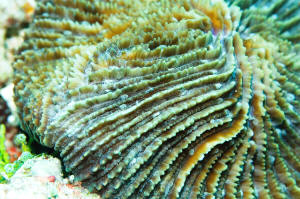 A Fungia
species... A Fungia
species...
|
How many species of corals have been known in
the world? 11/7/06 Hello Bob, I'm
working for a non-governmental organization in Vietnam. We're
producing a magazine for children that is called Green Forest.
<Neat!> A child sent to us a question that asking the number of
corals in the world. I hope that you can help me to answer this
question. Moreover, could you tell me how many species of corals there
are in Vietnam or South-east Asia? <Mmm, I don't know exact
numbers, but Dr. Veron, Daphne Fautin may be able to help here (via the
Net)... Actual Stony Corals (Scleractinians) may be separately
searchable vs. all the other myriad Cnidarian groups/classes called
"corals"... To me, only the stonies and Soft Corals,
Alcyonaceans, are "true" corals...> Thank you
very much for your help and look forward to hearing from you soon,
Cheers, Thu Hien Education for
Nature-Vietnam <Please do search on the Net re numbers (total and
Vietnam) for Scleractinia and Alcyonacea. Bob Fenner> What
is on this leather? 9/18/06 We are having a discussion on our local
forum. There appears to be a worm or a sweeper tentacle on this yellow
Fiji leather (Sarcophyton sp). <Does appear so to me as well>
Some of us were under the impression that leathers fought for territory
via chemical warfare, and didn't have sweeper tentacles similar to
LPS. <This is my impression, recollection as well... And a cursory
look/see in my library at hand and the Net shows this as well> Many
of us believe it to be a Digitate Hydroid. Please check out the video
and tell us what you think. VIDEO < http://www.sykesweb.com/210%20Tank/video/yellow%20fiji%20leather.wmv>
Thanks!! -Chuck Jordan <Could be this as well... and even another
possibility... some form/species of filter-feeding polychaete worm. I
would send this video to folks at Colleges that have invertebrate
zoology departments for their guesses/input. My first guess would be
the hydroid. Bob Fenner>
| What is this? Bad news... hydroids
8/1/06 My tank has become over-ran with this ( I think ) pest.
<Is... serious> The local aquarium dealer has no idea what it
is either (see attached images). I have had an Aiptasia problem but
I thought I had it under control. I would like your opinion if this
really is a pest, or is it something I should not worry about.
<You should... I would take "drastic action" here>
It seems to have covered the live rock in my tank as well as the
fake plants I have put in. The fish in my tank are all fine except
for the black cap basslet which now has white scarring along his
head (he is the only fish that hides in tight spaces, which is why
I think he may have more contact than any of the other fish). Any
help would be great. Please email me back at: Thanks, Shamus <I
would consider "nuking" this system... biocidally
bleaching it... Please read here: http://wetwebmedia.com/hyzoancompfaq.htm
and the linked files above. Bob Fenner> |
|
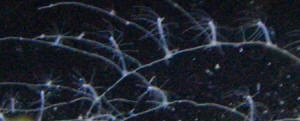 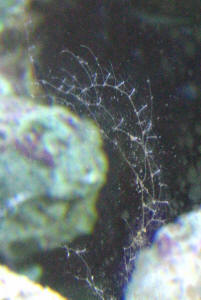
|
Coral ID 7/8/06 Hi crew hope you
are all fine, It's been a few months since I last spoke to you.
I have set up a 120G (UK) tank with a 65G sump to have as a reef.
Tank has been cycled and has been officially running for 4 months.
I added 100lbs of new Fiji live rock and left the tank free of fish
for 3 months to build on the pod population and various algae to
grow. Of which I have an abundance of scroll algae (beautiful) and
a lot of Caulerpa racemosa and a tiny amount of Halimeda. My
parameters have never been so steady, sg 1.024, temp 78F, ammonia
0, nitrate 0, nitrite 0, calcium 390, pH 8.2 (reverse
photo period with sump), alk 9.6. Anyway to the point, I have
attached an image to the email, it was a piece of live rock which I
could see was an old coral skeleton, I looked and guessed it may
have been a Stylophora but I am no expert yet! The rock has a lot
of tiny holes which I guessed would be where the polyps would come
out from when it was alive. Since being in the tank now for 4
months it appears that there is some orange growth of I guess flesh
although firm to the touch and as you will see from the picture
tiny white dots which I know are polyps as they come out during day
and night, these are small about an eighth of an inch across. Could
you shed some light and tell me what it is? <Mmm, judging from
the small corallite size, color, overall shape of this creeping
colony, I'd say it's some species of Porites> It's
located 12" from the top of the water surface, in medium flow
water with 2 x 250W MH.
Many thanks
Dave G (UK)
<Bob Fenner> |
|
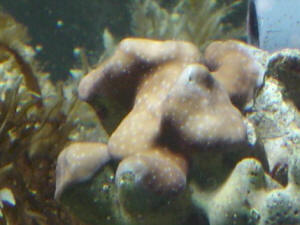
|
| Polypoid Hydroid... 7/7/06 Howdy
Bob; <Gerald> I have a strange
critter that has shown up in my tank; It is a medusae
with 10 tentacle branches, I have no clue and everyone tells me
hydroid and I keep saying hydroid is way too big an answer, I want
it narrowed down. I do have a
gorgonian in the tank. <Mmm... is likely a hydroid of some sort,
but I don't know any further/smaller classification for this
either. It may well be that this is not a welcome visitor... that
it and others that will arise from some part of your hard substrate
will mal-affect the health of other life in your system. The tough
part is how to find, remove these new strobilized individuals over
time. Bob Fenner> |
|
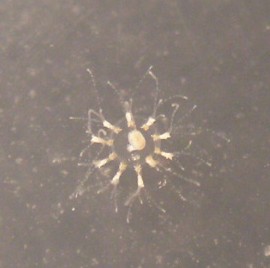
|
Mystery Softies, Cnid. IDs 6/25/06 -
Dear WWM Crew, <Morgan> I am a long time reader/researcher
and have enjoyed your site for quite some time. I am a
big fan of researching before I buy, and I do not like to purchase
a coral without research and careful
consideration. However, I have some
hitchhiker softies that came out into the light while curing and
quarantining. They are very small still, but are rapidly
spreading, and I would like to know the species, or at least the
genus, with some certainty so I can care for them and protect my
other corals if necessary. This tank is a nano with lots of live
rock and very happy symbiotic softies, including anthelia, finger
coral, xenia, and leathers, among others, all
spreading. I also have several small zoanthid colonies
and lots of strange hitchhikers, like bivalves, tunicates, young
serpent stars, and pistol shrimp (I've never seen them, but
they keep me awake at night with subsequent pops when something
gets too close to their little hideouts). I have also
pulled off several tiny whelk/conch animals and some tiny
mysterious crabs for evaluation in isolation. Everything
is great; my peppermint shrimp pair breed and my tiny blenny keeps
everything spotless and algae-free. However, these guys
are a mystery, and I would like to know if anyone has any
ideas. They are all on different rocks purchased at
different times. The first image contains an animal that came in on
what was labeled as Marshall Island live rocks, but I am not
sure. They have eight pinnuled tentacles each, and
appear to be encrusting. <Look like clavulariids... perhaps a
gorgonian> When I first saw them they were clearly
connected underneath a mass of hard holes (spicules?) that looked
to be part of the live rock. It seemed stony, so I
thought perhaps it an encrusting gorgonian. <Could be>
Now I believe it to be Briareum, after reading previous
posts. As it got happier, more and more polyps emerged
from the holes, and it began to spread with a pinkish tissue from
around the base, spawning tiny new polyps. It strongly
resembles B. asbestinum, but I cannot find a trustworthy image of a
retracted colony to compare. It would make sense
geographically, though, if it were Marshall Island rock, right?
<Possibly> (It would also make sense, as
something made me sick after cutting my finger on a sharp something
in my tank - I blamed palytoxin, but perhaps Briarne?)
<Yes...> Obviously, it had suffered severe damage before
coming into my possession, and it may be a wild-caught
colony. The top images are with and without flash, and
the bottom image is of a dead colony that resembles the retracted
live colony. The second image is of a tiny red polyp. It
is VERY tiny, smaller than 1 cm in diameter. It is a
deep, velvet red with white centers. It is almost
certainly encrusting, but there is one polyp not in the image that
lives alone (perhaps coralline algae has grown over the
base?). These did not emerge until well after the
zoanthid colony it was on finished quarantine. It seems
photoreceptive (it retracts at night), so perhaps an encrusting
zooxanthellic gorgonian or an encrusting star polyp? <I'd
guess the latter> I have no idea - definitely an octocoral, but
flatter than any gorgonian I know if. Also red tentacles
with a white oral disc - what could it be? <Or another Zoanthid
species> The third and final image it the most
troubling. The polyps are very beautiful and resemble
snowflakes. They were white but are getting more brown
(zooxanthellic change/regrowth?) It lays flat like the
second mystery polyp, but is a tiny bit larger. The rock
it came on was the reason I purchased the Sarcophyton above it, and
the whole rock is really held together with sponges and tunicates
and coralline algae. These polyps came into light and
began to reproduce, from two to over a dozen, including some young
ones. I believe the choenchyme might show it to be more
like Protoalyconaria (Cornularia sp? with small polyps?) than a
Scleraxonia, but I cannot be sure because of the nature of the rock
it inhabits. The image is very poor, and I am sorry. I
would be really grateful if you help me out! Thank you, Morgan
<Can't really make this out of your image. Bob
Fenner> |
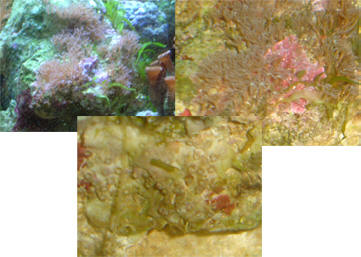
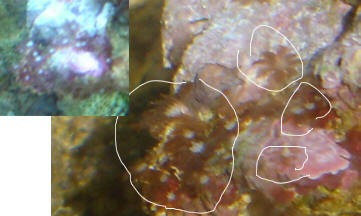 |
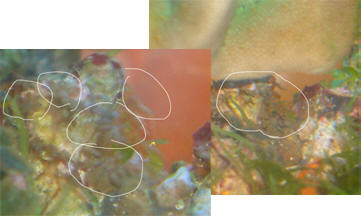 |
|
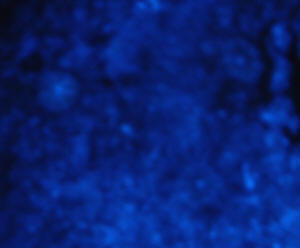 If I stare too long, will I see the devil? If I stare too long, will I see the devil?
|
| Re: Mystery nocturnal 'polyps'
6/13/06 Managed to get some better pics at light up today, from
generally the same area.. One pic is with full lighting, the other
actinic only... you can see the tentacles of another polypoid in
the upper right corner of the full light picture, but neither
captured the vivid colorations they have around the centers. Do
these pictures give you a better idea what I'm dealing with?
Pest or pleasant gift? Thanks, Justin <Not much better idea...
still some sort of polypoid animal... perhaps a small actinarian...
I would leave these as they are if they are not excluding other
benthic life. Bob Fenner> |
|
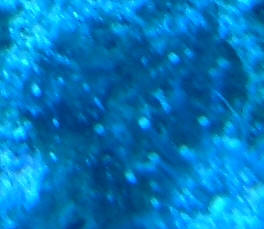
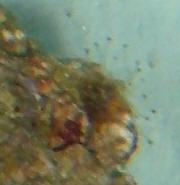
|
| Mystery nocturnal 'polyps' 6/12/06
Hey Crew, <Justin> Hate to bother again, but these things
have been boggling me for weeks now, and I can't find anything
comparable anywhere. There are about 5 of them loosely gathered on
a single piece of live rock, and shut themselves during the day,
about 5 minutes after the lights come on in the morning. The body
of the 'polyp' is about the size of a dime when opened, and
have many 'tentacles' which are not visible in the picture
that about 1/2 of an inch beyond this diameter. They appear to be
largely clear under standard lighting, but very fluorescent under
actinic/blue wavelength LED penlight (I used the LED for the
pictures). The tentacles are clear with a bluish glowing tip, and
the inner body of the 'polyp' has many shades throughout
it, ranging from red to blue. When they close up during the day,
they appear as a small brown mound with the center mouth of the
'polyp' still visible in the center. My camera's flash
is not functioning correctly, and getting a picture of them open is
very difficult, <I can or can't see this for sure> at
least for the time being. There are 3 'polyps' in the
picture, 2 in either upper corner, one near the middle in the lower
half. My first thought was pest anemones, but I can't find any
that look at all like this. Help! Thanks, Justin <Some sort of
polypoid animal, but I can't make out any more from your
description, pic. Bob Fenner> |
|
|

